

Marquetry has pictures that depict anything from still life arrangements to figural compositions. Given the intricate and non-uniform nature of marquetry works, these are are most often used in smaller works or as a focal point within a larger overall composition.
Marquetry has long been perceived as a standout amongst the most appealing and modern methods of decorating fine furniture. The art of making sculptured ornaments in a wooden object creates undeniable beauty forms and shapes. It is a meticulous and creative task. Balancing, between a classic natural look and textures, to highly polished and coloured versions, wood has been a main raw material chosen by many artisans.

Marquetry is a process of creating patterns and designs on objects like furniture using thin veneers or layers of materials like hardwood, shell or ivory. Pieces are cut and fit together to form a very decorative flat surface image. Marquetry is an old process that dates back thousands of years. It is a popular way to decorate furniture. The term comes from an old French word ‘marqueter,’ which means to inlay.

“Seven Codes” cupboard by Trix and Robert Haussmann for Röthlisberger, mirror with wood veneer inlay
Floral marquetry designs on a Victorian centre table. Right: Diamond, or lozenge, pattern on a Victorian roll-top desk.
Marquetry work that you are most likely to encounter was introduced into England at the restoration of Charles II, 1630–1685, along with the arrivals in England of large numbers of Continental master craftsmen particularly in the early 18th century. Costly items of superb floral marquetry were created for the English taste. Popular forms were cabinets and longcase clock cases.

Floral marquetry designs on a Victorian centre table. Right: Diamond, or lozenge, pattern on a Victorian roll-top desk.

Louis XVI Style Inlaid Marquetry Commode
Marquetry’ work was rare in England until the reign of Queen Elizabeth I, 1533–1603, but had been practiced in Italy in the 16th century when hardstone inlays were highly fashionable. This technique was generally known in England as ‘Pietra Dura’, Italian for ‘hard stone’. It could be claimed that the Romans were the initiators of ‘marquetry’ work in their ancient mosaics and marble floors.

Most early inlay was geometric. Shaped marquetry came later. As such, marquetry differed substantially from inlay in that the design was essentially completed before being attached to the end piece of furniture, rather than being used as an element within the end piece. The earliest known example of marquetry (1563) is from Breslau, Germany.
Artists do marquetry by cutting, fitting and gluing pieces into a pre-planned pattern. The artist draws a pattern that identifies the shapes that will form the image and then chooses different types and colors of hardwood or other materials that he or she will use. The variety of materials available today is endless. In wood, dark shades come from trees like mahogany, ebony macassar and walnut while light colors come from ash and sycamore.

The artist might also choose specific woods for their distinctive grains or patterns. It is generally agreed that marquetry consists of inlay work, and strictly speaking only inlays made of wood can be designated as such, although inlays of other materials are generally also referred to as marquetry. When we talk about wood inlays we are generally referring to marquetry. This is the most common technique of wood inlay work, which is created with high-quality veneers that are glued on to a wooden base. Thanks to CNC technology furniture with inlay work can nowadays be manufactured in series production.

Its more like putting together a “puzzle” of great complexity, since many pieces of wood veneers which are are usually less than 1 mm thick.
This work has a challenge of how the different colours and the veins of wood veneers must be properly oriented to form mosaic pattern that will end up giving rise to a piece of furniture of great aesthetic and decorative value. For this reason, the work is done on a smooth surface of minimum thickness, which is then pasted on the furniture that needs to be decorated. Marquetry technique is employed to create flat ornamental designs in wood, with the main difference being what is depicted in these decorative features more like marquetry is used to create pictures in wood.

Marquetry artist Toby Winteringham: he immerses the pieces of veneer to be inlayed in hot sand, which creates a slight charring in the shading of the wood. In addition to the techniques of traditional craftsmanship Winteringham also applies CNC milling machines.
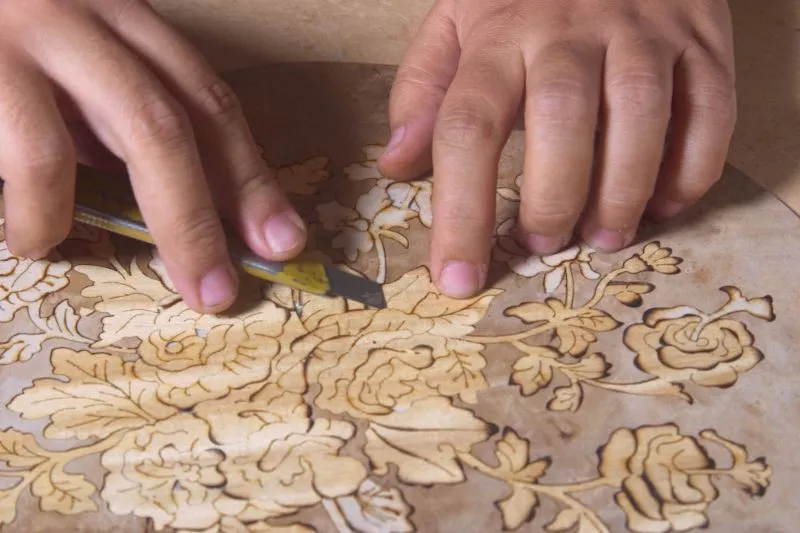
Many details and intricacies go into this art
“Bird” Sideboard by Toby Winteringham and his daughter Grace Winteringham; This marquetry design of birds, feathers and leaves is laser cut.
In addition to elaborate and intricate works his collection also contains simpler modern marquetry work which is no less sophisticated but is suited to larger production runs.

“Bird” Sideboard by Toby Winteringham and his daughter Grace Winteringham; This marquetry design of birds, feathers and leaves is laser cut.
This French antique marquetry panel is crafted in exotic woods which have been tinted in places with additional pigment, and shows just how colourful and intricate the craft can be
The artist cuts each small piece out of different woods, and then glues them into place following the pattern. Marquetry designs are done by hand, one at a time, so patience is required. It can take many hours to finish a single design. When the pattern is finished, the veneers are gently sanded so they are level with each other, and then a clear, protective finish like varnish is often applied.
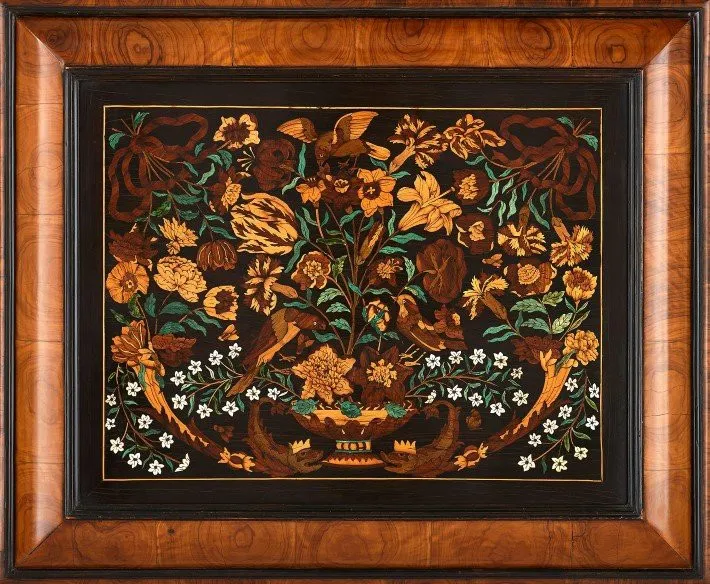
This French antique marquetry panel is crafted in exotic woods which have been tinted in places with additional pigment, and shows just how colourful and intricate the craft can be
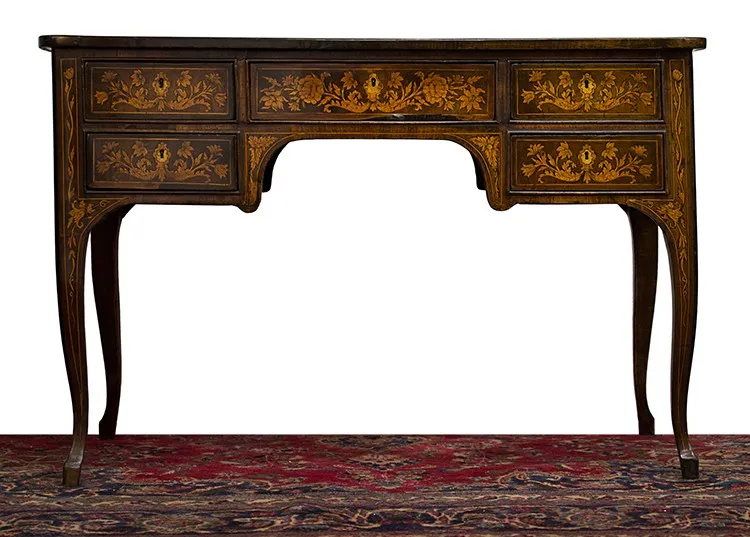
Several tools are helpful to marquetry artists. One of the most important is the fret saw, invented in the mid-16th century. The fret saw is a hand saw that has a very thin blade and extremely fine teeth. It’s attached to a U-shaped support that helps to hold the blade rigid. Artists use the fret saw to cut the thin layers of material into complex shapes, even those with tight curves. Some artists also work with electric scroll saws and small sharp blades like those of an X-Acto knife.
Patterns and Designs
Many patterns and decorations can be done with marquetry. Skilled artists can create beautiful patterns through varying the colors, textures and grains of hardwoods. Sometimes they also incorporate other substances.
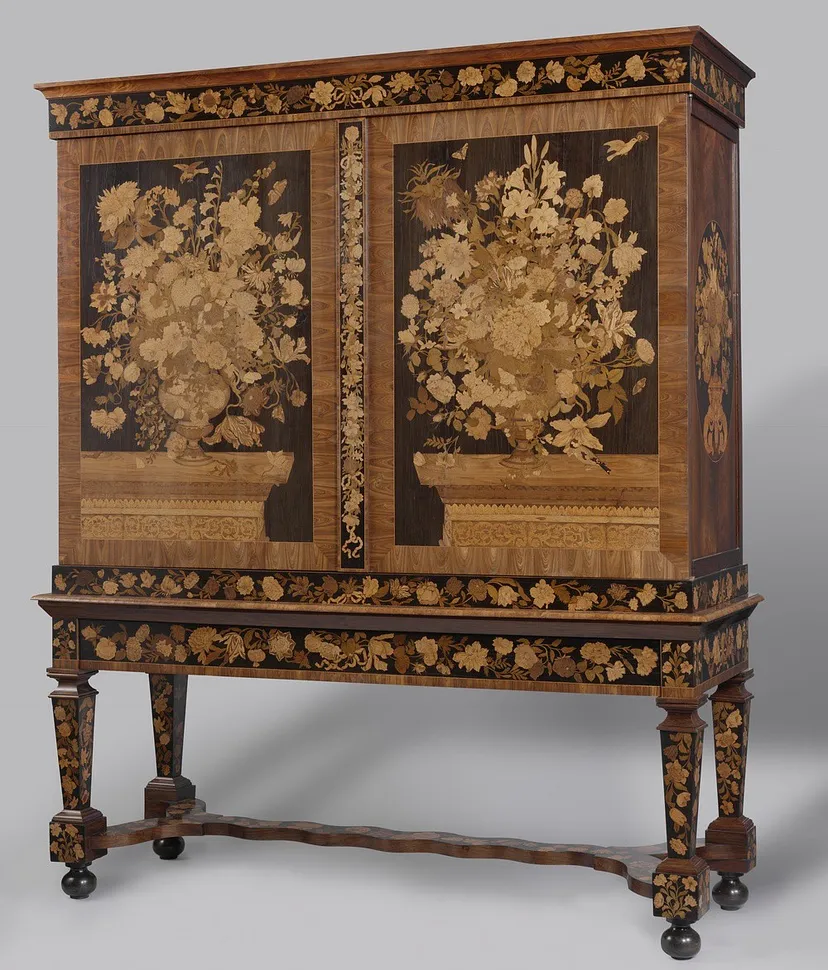
A style of marquetry known as Boulle marquetry was popular in France in the late 17th and early 18th centuries. It used brass, tortoise shell, and mother-of-pearl on elaborate furniture pieces. It was created by a French cabinet maker named Andre-Charles Boulle, who raised marquetry to a sophisticated art. By 1672, he was a highly sought-after artist who was working in the royal workshop of King Louis XIV.
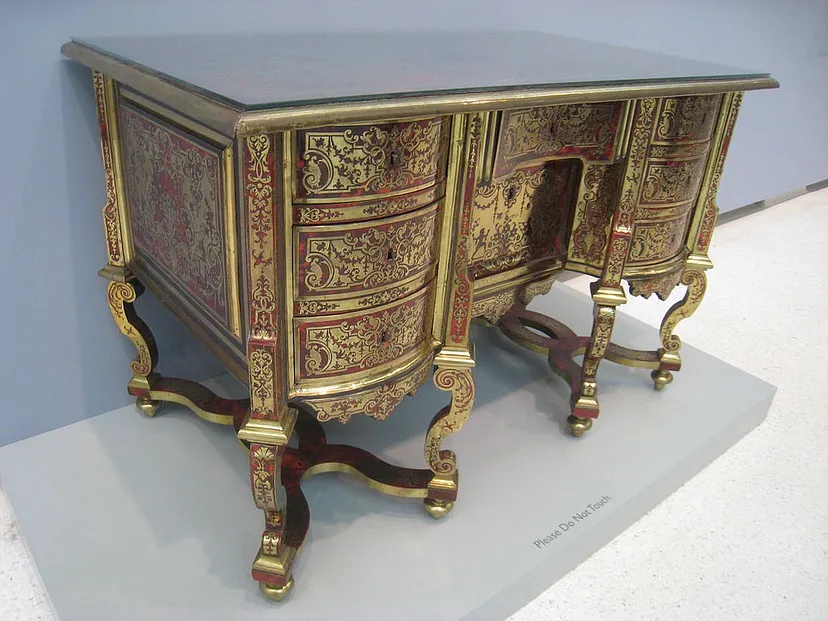
Boulle Marquetry
There are several techniques used to create marquetry, but all of them start with a design for a composition on paper which is ultimately translated into a wooden veneer.
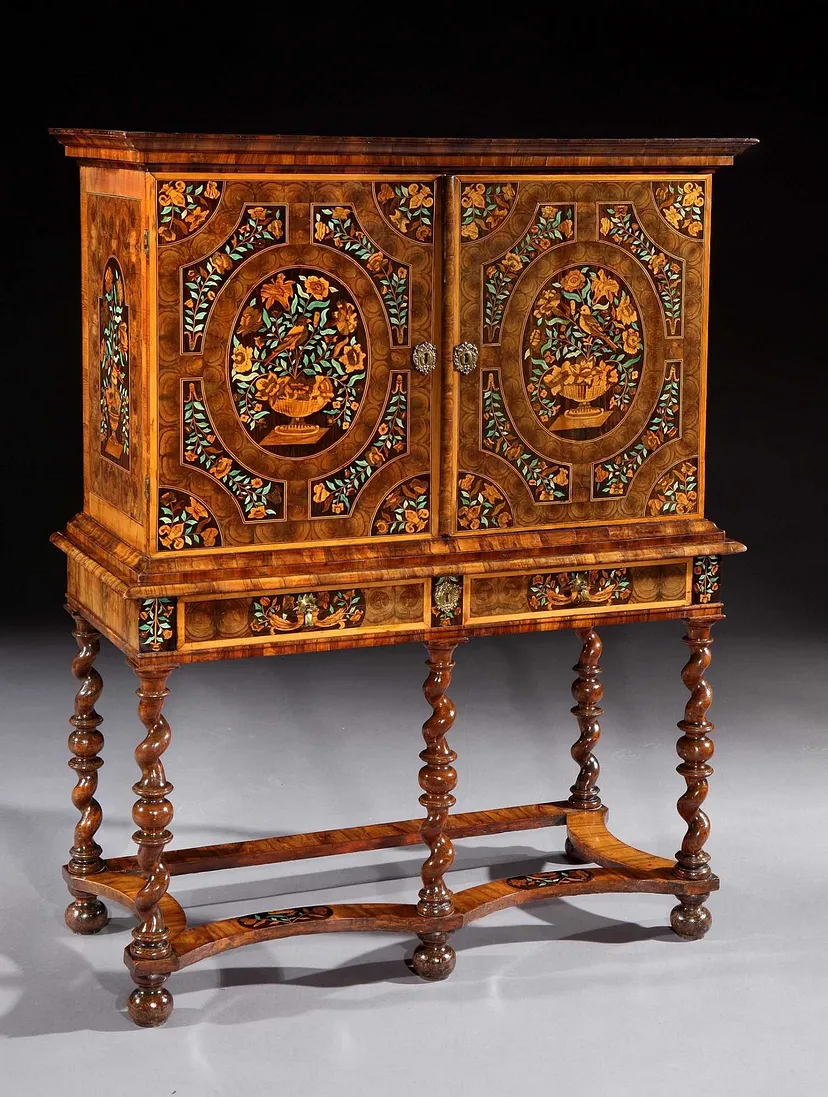
A William & Mary marquetry cabinet
It is easy to imagine that marquetry is a lot like sculpting, crafting intricate designs into a very hard surface that requires a great deal of manipulation. However, the veneer required for marquetry is exceptionally thin, like a wooden paper, and can easily be scored into shape.

To begin, the marqueter who completes the process considers which parts of the composition will be made of which different types of wood, and arranges the motifs so that they can are contrasting.
The design for the composition is firstly either traced or stuck onto the different colours of veneer, and is then cut out with a knife blade. Being so thin, veneer is very brittle and dry, and so care must be taken by the marqueteur around especially delicate sections.
Holes, or windows, in the shape of the design are left in the sheet of veneer when the entire composition has been cut out, which can now be filled with a veneer of a contrasting colour and glued into place.
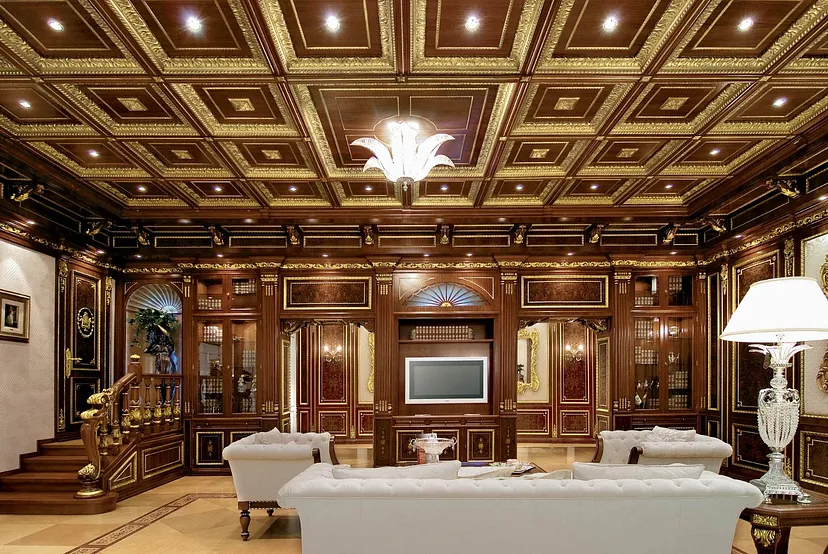
Marquetry by hand, detailed work at Muebles Picó
Marquetry compositions are fragile, even when glued together, and so must be affixed onto a more sturdy surface with glue. They are often stuck onto a piece of furniture or a wooden panel that serves as a canvas.

The marquetry compositions are then varnished to protect the woodwork, and to give the veneer a shine. The varnish also accentuates the colours of the marquetry panel, allowing them to stand out against each other.

Marquetry is labour intensive and requires a high level of craftsmanship to complete, and this is why it has long been considered one of the most important woodwork techniques.
Marquetry is used for many purposes in furniture and the decorative arts. Many pieces of furniture feature inlaid marquetry sections, although some of the very finest pieces are almost entirely veneered with marquetry. Traditionally, the more marquetry that is incorporated into a piece and the better it is executed, the more valuable and often the more collectible it is.

It is amazing to know that these gorgeous pieces of furniture art are still available and in beautiful condition. The talented artisans responsible for creating them would be proud to know that their fine marquetry not only continues to be appreciated but is also used and enjoyed in the 21st Century!
The author of this article is Dr. Vinita Mathur (vinita @dezyneecole.com),she is an esteemed educationist, and the visionary owner of a prestigious college ,Dezyne École College . Her intellectual prowess, dedication to education, and innovative leadership have made her a prominent figure in academia and a source of inspiration for countless students and educators alike.
Through her scholarly pursuits, educational leadership, and commitment to empowering students, she has left an indelible mark on the educational landscape.